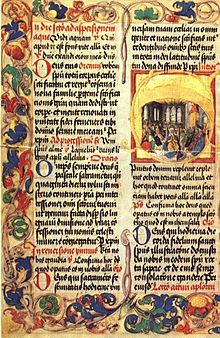
Back Rubrik (Liturgie) BAR Рубрыка (ініцыял) Byelorussian Rúbrica Catalan Rubrika Czech Rubrik (Liturgie) German Rúbrica (libro) Spanish Rubrique typographique French Rubrik ID Rubriko IO Rubriek (handschrift) Dutch


A rubric is a word or section of text that is traditionally written or printed in red ink for emphasis. The word derives from the Latin rubrica, meaning red ochre or red chalk,[1] and originates in medieval illuminated manuscripts from the 13th century or earlier. In these, red letters were used to highlight initial capitals (particularly of psalms), section headings and names of religious significance, a practice known as rubrication, which was a separate stage in the production of a manuscript.
Rubric can also mean the red ink or paint used to make rubrics, or the pigment used to make it.[2] Although red was most often used, other colours came into use from the late Middle Ages onwards, and the word rubric was used for these also. Medievalists can use patterns of rubrication to help identify textual traditions.[3]
Various figurative senses of the word have been extended from its original meaning. Usually these senses are used within the set phrase "under [whatever] rubric", for example, "under this rubric, [X is true]", or "[X was done] under the rubric of Y". Such senses include: "an authoritative rule";[4] "the title of a statute";[4] "something under which a thing is classed";[4] "an explanatory or introductory commentary";[4] "an established rule, tradition, or custom";[4] or "a guide listing specific criteria for grading or scoring academic assignments".[4]
- ^ OED meaning 1a.
- ^ OED meaning 1b
- ^ Stephanie Viereck Gibbs Kamath (2010). "Rubrics". In Dunphy, Graeme (ed.). Encyclopedia of the Medieval Chronicle. Leiden: Brill. pp. 1301–1303. ISBN 90-04-18464-3.
- ^ a b c d e f "rubric". Merriam-Webster's Collegiate Dictionary (11th ed.). Merriam-Webster. 11 March 2024.